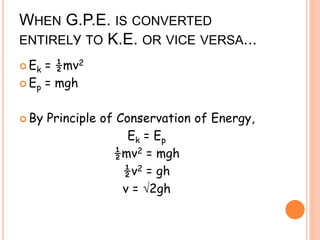Energy and Efficiency
- 1. WHEN G.P.E. IS CONVERTED ENTIRELY TO K.E. OR VICE VERSA... ïĒ Ek = Â―mv2 ïĒ Ep = mgh ïĒ By Principle of Conservation of Energy, Ek = Ep Â―mv2 = mgh Â―v2 = gh v = ï2gh
- 2. 2 Principle of Conservation of Energy and the non-ideal pendulum 1. Lost in EP ïĻ Gain in EK + Thermal energy (friction) 2. Lost in EK ïĻ Gain in EP + Thermal energy (friction) Height gained is lower than the original because some of the energy has been converted to thermal energy. (1) (2) The pendulum eventually comes to a stop. Video - Ballistic pendulum
- 3. EFFICIENCY What does efficiency refer to?
- 4. EFFICIENCY ïĒ Recall Senoko Power Station: ïĒ Note the conversion of energy from one form to another
- 5. EFFICIENCY ïĒ Do you agree? The chemical energy of the fuel is fully converted to electrical energy because the Principle of Conservation of Energy states that energy cannot be created nor destroyed.
- 6. EFFICIENCY ïĒ Some of the energy is converted to heat, light and sound. The energy conversion is thus not 100% Wouldnât this violate the Principle of Conservation of Energy?
- 7. EFFICIENCY No, because the total sum of heat, light, sound and electrical energy is equal to the chemical energy of the fuel
- 8. LIGHT BULB
- 9. EFFICIENCY ïĒ In a system, the ratio of useful energy output to the total energy input is known as the efficiency of the system. ïĒ Efficiency is expressed as a percentage
- 10. EFFICIENCY ïĒ Calculate the efficiency of the light bulb.










